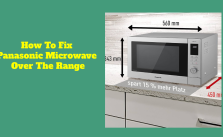If you own a Panasonic microwave over the range, you know how convenient and versatile it is. You can cook, reheat, defrost, and even grill your food.
But what if your microwave stops working correctly? What if it has no power, no display, or no heat? How can you fix it yourself without spending hundreds of dollars on a replacement or a repair service?
I will show you how to troubleshoot and fix some of the most common problems affecting your Panasonic microwave over the range.
You don’t need to be an expert or have special tools to do this. All you need is basic knowledge, a screwdriver, and a multimeter. Implementing these straightforward guidelines will help you achieve time efficiency, money, and hassle and enjoy your microwave again.
Disclaimer
Before we start, I want to make a clear disclaimer. The singular objective of this blog post is to furnish informative content. I am not a professional technician or a certified repairman.
I am just a fellow Panasonic microwave owner who has researched and experimented on how to fix my microwave. I am not responsible for any damage or injury that may occur as a result of following this guide. Please use caution and common sense when working with electrical appliances.
If you are not confident or comfortable doing this, please consult a professional or contact Panasonic customer service.
Safety precautions
Before you attempt to fix your microwave, you need to take some safety precautions. Here are some essential tips to remember:
1. Unplug your microwave from the power outlet before you open it or touch any of its components. Even if your microwave has no power or display, it may still have some residual voltage in its capacitors that can shock you or damage the circuit board.
2. Discharge the high-voltage capacitor before touching any wires or components inside the microwave. The capacitor is a significant cylindrical metal component that stores high-voltage electricity for the magnetron, which is the part that generates the microwaves.
The capacitor can hold a lethal charge even after the microwave is unplugged. It would be best to use a screwdriver with an insulated handle and a wire to discharge it.
Connect one end of the wire to the metal chassis of the microwave and touch the other end to each of the capacitor terminals, one at a time.
You may hear a loud pop or see a spark when you do this. This means that the capacitor is discharged and safe to handle. Be careful not to touch the metal part of the screwdriver or the wire, as they may be hot.
3. Make sure you are wearing some gloves and also google for eye protection when working with the microwave. Some of the microwave components may have sharp edges or even holes that could cut or poke you.
Also, some wires may have exposed ends that can cause electric shocks or burns. Wearing gloves and eye protection can prevent injuries and infections.
4. Please do not touch the magnetron or its wires. The magnetron is the part that generates the microwaves that heat your food. It is usually a silver or black metal cylinder with fins and wires attached.
The magnetron may contain beryllium oxide, a toxic and carcinogenic substance. If the magnetron is damaged or cracked, it may release beryllium oxide dust or vapors that can harm your health.
If you suspect the magnetron is faulty, do not touch or try to fix it. Replace it with a new one or contact a professional.
Common problems and solutions
Having implemented the required safety measures, you can proceed confidently and troubleshoot and fix your microwave. Here are some of the most common problems affecting your Panasonic microwave over the range and how to solve them.
No power or display
If your microwave has no power or display, it means no electricity reaches the microwave. This could be due to a faulty power cord, a blown fuse, a tripped circuit breaker, or a bad door switch. Here is how to check and fix each of these causes:
1. Power cord: The cable that serves as a means of connection is the power cord, which helps connect your microwave to the wall outlet. Sometimes, the power cord may get damaged, loose, or unplugged, preventing the microwave from gaining power.
To check the power cord, you need to use a multimeter, which is a device that measures voltage, current, and resistance. Set the multimeter to the continuity mode, usually indicated by a symbol resembling a sound wave. Then, touch the multimeter probes to each end of the power cord.
The power cord is suitable if the multimeter beeps or shows a low resistance reading. If the multimeter does not beep or offers a high resistance or infinity reading, the power cord is wrong and needs to be replaced.
2. Fuse: The fuse is a small cylindrical component that protects the microwave from power surges or short circuits. It is usually inside the microwave, the power cord, or the control board. If the fuse blows, it will cut off the power to the microwave.
To check the fuse, you need to use a multimeter. To check the fuse, adjust the multimeter to continuity mode and carefully position the probes on both ends. The fuse is good if the multimeter beeps or shows a low resistance reading. If the multimeter does not beep or offers a high resistance or infinity reading, the fuse is blown and needs to be replaced.
You need to unplug the microwave, open the microwave case, locate the fuse, and remove it to replace it. Then, close the microwave case and insert a new fuse of the same type and rating. Plug the microwave back in and test it. If the fuse blows again, it means that there is a deeper problem with the microwave, and you need to contact a professional.
3. Circuit breaker: The circute breaker is an important device ehich serve as a switch that controls the power supply to your microwave and other appliances in your home. Sometimes, the circuit breaker may trip, so it turns off the power to prevent overloading or short-circuiting. This can happen if you use too many appliances simultaneously or if there is a power outage or surge.
To check the circuit breaker, you must go to the electrical panel in your basement, garage, or closet. Look for the switch that corresponds to your microwave or kitchen. If the switch is in the off or middle position, the circuit breaker has tripped.
To reset the circuit breaker, turn the switch to the on position. Then, go back to your microwave and test it. If the circuit breaker trips again, it means that there is a problem with the wiring or the microwave, and you need to contact a professional.
4. Door switch: The door switch is a small device that detects whether the microwave door is open or closed. It is usually located inside the microwave, near the door latch. Should the door switch prove faulty, the microwave may be rendered powerless or prevented from initiating.
To check the door switch, you need to use a multimeter. Adjust the multimeter to continuity mode to fit the door switch and place the probes on its terminals. Then, open and close the microwave door. If the multimeter beeps or shows a low resistance reading when the door is closed and does not beep or reveal a high resistance or infinity reading when the door is open, it means the door switch is good.
If the multimeter does not change its reading when the door is opened or closed, it means the door switch is wrong and must be replaced. Before replacing the door switch, it is imperative to unplug the microwave, open the microwave case, locate the door switch, and remove it. Then, close the microwave case and insert a new door switch of the same type and model. Plug the microwave back in and test it.
No heat
If your microwave has power and display but does not heat your food, it means there is a problem with the magnetron, the diode, the capacitor, or the transformer. These components generate and amplify the microwaves that heat your food. Here is how to check and fix each of these causes:
1. Magnetron: The magnetron is the part that generates the microwaves that heat your food. It is usually a silver or black metal cylinder with fins and wires attached. If the magnetron is faulty, it may not produce weak or irregular microwaves.
To check the magnetron, you need to use a multimeter. Set the multimeter to the resistance mode, usually indicated by a symbol that looks like an ohm. Then, touch the multimeter probes to each magnetron terminal. If the multimeter displays a low resistance reading, it may indicate a potential issue, and the magnetron is exemplary.
If the multimeter shows a high resistance or infinity reading, the magnetron is terrible and needs to be replaced. You need to unplug the microwave, discharge the capacitor, open the microwave case, locate the magnetron, and remove it to replace it.
Then, close the microwave case and insert a new magnetron of the same type and model. Plug the microwave back in and test it. Remember, do not touch the magnetron or its wires, as they may contain current.
2. Diode: The diode, a compact device, enables the flow of current in a single direction. It is usually located near the capacitor with a thick black wire and a thin red wire attached.
If the diode is faulty, it may not allow the current to flow to the magnetron or soak in both directions, damaging the magnetron. To check the diode, you need to use a multimeter. Set the multimeter to the resistance mode and touch the probes to each end of the diode.
Then, reverse the probes and connect them again. The diode is suitable if the multimeter shows a low resistance reading in one direction and a high resistance or infinity reading in the other. If the multimeter shows the same reading in both directions or no reading at all, the diode is wrong and needs to be replaced.
To replace the diode, you need to unplug the microwave, discharge the capacitor, open the microwave case, locate the diode, and remove it. Then, close the microwave case and insert a new diode of the same type and model. Plug the microwave back in and test it.
3. Capacitor: The capacitor is a significant cylindrical metal component that stores high-voltage electricity for the magnetron. It is usually located near the transformer and has two or three terminals on top of it.
If the capacitor is faulty, it may not store enough or leak charge, which can affect the power and frequency of the microwaves. To check the capacitor, you need to use a multimeter. Set the multimeter to the capacitance mode, usually indicated by a symbol resembling a capacitor.
Then, touch the probes to the terminals of the capacitor. If the multimeter shows a reading that matches the rating of the capacitor, it means that the capacitor is suitable. If the multimeter shows a reading that is too low, too high, or fluctuating, the capacitor is wrong and needs to be replaced.
To replace the capacitor, you need to unplug the microwave, discharge it, open the microwave case, locate the capacitor, and remove it. Then, insert a new capacitor of the same type and rating and close the microwave case. Plug the microwave back in and test it.
4. Transformer: The transformer is a significant metal component that converts the low voltage electricity from the power outlet to the high voltage electricity for the magnetron.
It is usually located at the back of the microwave and has four wires attached. If the transformer is faulty, it may not provide enough or too much voltage, which can damage the magnetron or the other components. To check the transformer, you need to use a multimeter. Set the multimeter to the voltage mode, usually indicated by a symbol that looks like a V.
Then, touch the probes to the wires of the transformer. If the multimeter shows a reading that matches the transformer’s input and output voltages, it means that the transformer is suitable. If the multimeter shows a reading that is too low, too high, or inconsistent, the transformer is wrong and needs to be replaced.
To replace the transformer, you need to unplug the microwave, discharge the capacitor, open the microwave case, locate the transformer, and remove it. Then, insert a new transformer of the same type and model and close the microwave case. Plug the microwave back in and test it.
Conclusion
I have helped you learn how to fix a Panasonic microwave over the range. Following these step-by-step guides, you can troubleshoot and fix some of the most common problems affecting your microwave.
You can also save money and time by doing it yourself instead of hiring a professional or buying a new one. If you are unsure or uncomfortable with doing this, or if the problem persists or worsens, please contact a professional or Panasonic customer service for assistance.



